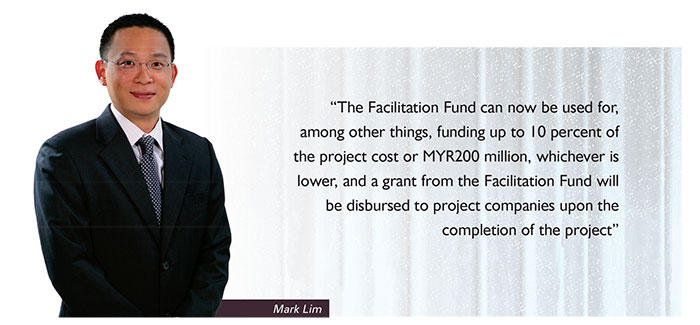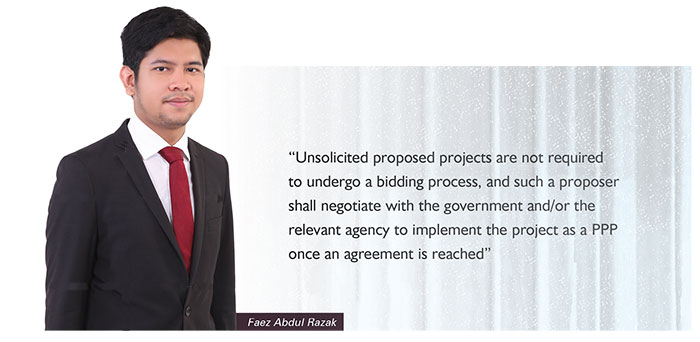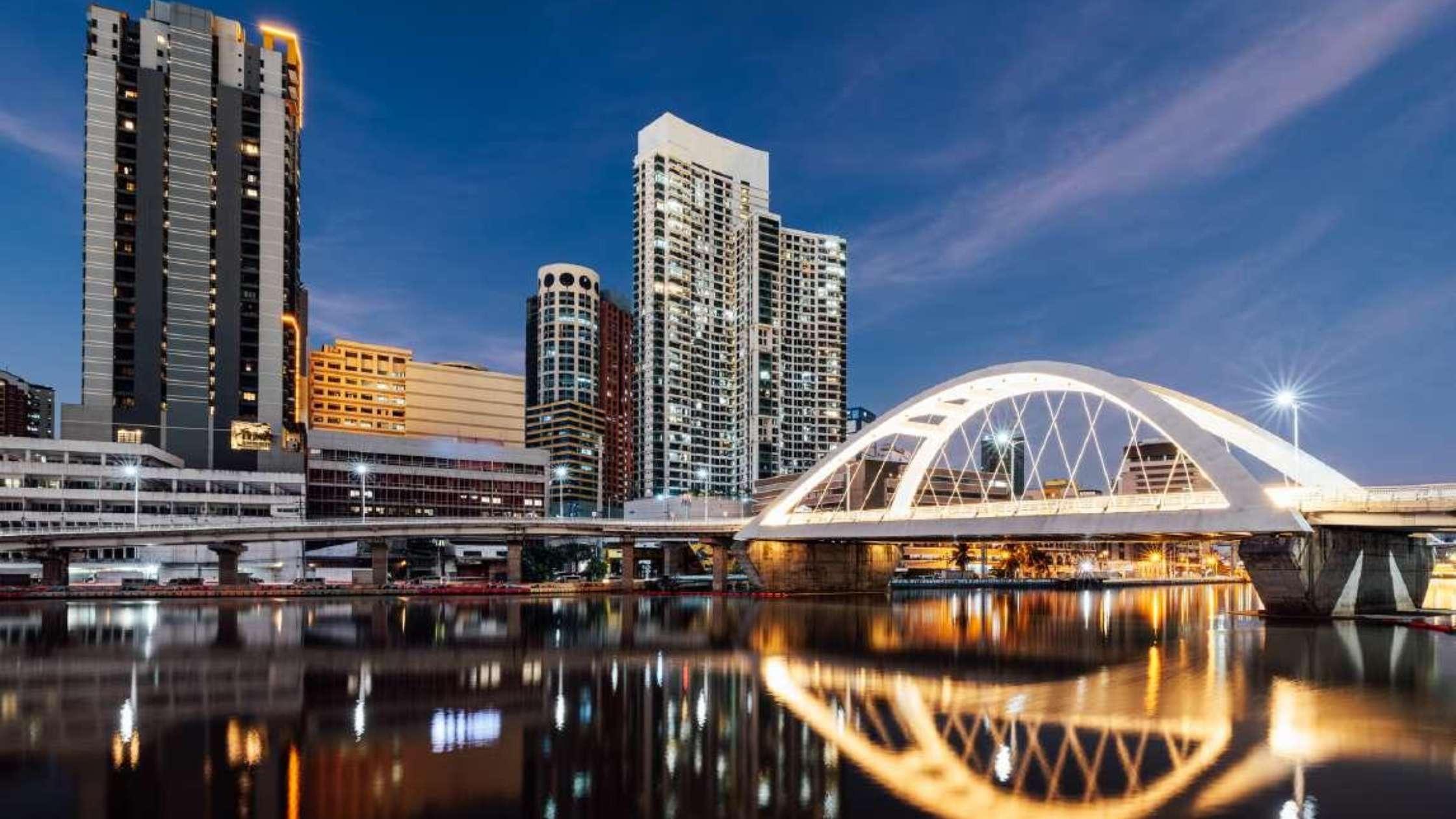Discussing Public Private Partnerships (PPPs) in Malaysia, Mark Lim and Faez Abdul Razak of Wong & Partners give their insight into how to navigate guidelines and attain grants in Malaysia under the current Eleventh Malaysia Plan.
1. Infrastructure developments in Malaysia
In Malaysia, privatisation of public projects and Public Private Partnership (PPP) projects have been ongoing since the 1980s, which ranks the country second highest on its infrastructure development after Singapore among the ASEAN member states1. The country’s ambition to become a developed country under its ‘Vision 2020’ national plan meant that the development of social infrastructure such as urban transportation and medical facilities is still in high demand. PPP is expected to be one of the drivers of such developments. In this regard, the Tenth Malaysia Plan (2011-2015), the previous mid-term development plan of Malaysia, includes strategic PPP-related targets. According to the Tenth Malaysia Plan, MYR230 billion have been allocated for development purposes, including the PPP and the Facilitation Fund, which was established with approximately MYR20 billion. This tendency to put a high value on infrastructure development that utilises PPP has been continued under the current Eleventh Malaysia Plan (2016-2020).
2. Legal framework in relation to PPP
(1) Laws and guidelines
In Malaysia, there is no fundamental PPP law. PPP projects are implemented under various guidelines (including those set out below) in addition to the individual laws for each sector (e.g. Electricity Supply Act, Railways Act and Federal Roads Act). These guidelines present the PPP framework, as well as the requirements and selection procedures for PPP projects and project companies, but neither of these guidelines and laws have detailed provisions2. UKAS (3PU), the core agency to lead PPP under the Prime Minister’s Department and relevant agencies, have broad discretion with regard to the contents and operation of PPP projects.
Below is a summary of the key guidelines:
(i) Privatisation Master Plan
The Privatisation Master Plan was developed in 1991 as a privatisation policy for government-owned companies and government-initiated projects. While it seemed to be more related to privatisation as compared to PPP, this plan, together with the PPP Guidelines (described below), also applies to PPP projects to a certain extent. For example, although foreign participation is limited to a maximum of 25 percent under this plan, the permissible foreign participation would largely depend on the requirements in the bid proposal of a specific PPP project, unless UKAS specifically refers to this plan. For example, in the bid documents for the last independent power producer (IPP) open tender held in 2013, the successful bidder was required to incorporate a local company with effective Malaysian equity interest of at least 51 percent. Such concession suggests that 49 percent of foreign participation was granted for that project.
(ii) PPP Guidelines
The PPP Guidelines were established under the Ninth Malaysia Plan (2006-2010) to complement the Privatisation Master Plan. The PPP Guidelines provide the framework of PPP in Malaysia, such as the principles of adopting the PPP approach, definition of PPP (both the stand-alone model and the service payment model), difference between public projects and privatisation, submission of PPP proposal, general criteria for PPP projects (e.g. the sponsor of a project must be financially strong with a paid-up capital of the project company to be at least 10 percent of the project value3), roles and responsibilities of the private and public sectors in PPP and the overall process flow of the PPP projects. Since the PPP Guidelines is a very simple and concise document, the details of each project defer to the decisions made by UKAS and other governmental agencies and bid documents.
(iii) Facilitation Fund Guidelines
As previously mentioned, the government has introduced the Facilitation Fund, worth MYR20 billion under the Tenth Malaysia Plan, as a form of support for public projects. The purpose of the Facilitation Fund is to bridge the viability gap and stimulate private investments in PPP projects in priority areas such as infrastructure, education, tourism and health.
The Facilitation Fund Guidelines (FF Guidelines) were first issued in 2011 to set out the scope of operations of the Facilitation Fund. According to the FF Guidelines, any financing provided by the Facilitation Fund was to be provided in the form of a grant, and such grant was to be used only for the development of the basic infrastructure of a project, such as access roads, bridges and utilities. However, there were no provisions regarding the amount of the grant to be provided or the criteria for the eligibility of projects. In 2014, several amendments were made to the FF Guidelines including the removal of the limitation on the use of a grant from the Facilitation Fund. The Facilitation Fund can now be used for, among other things, funding up to 10 percent of the project cost or MYR200 million, whichever is lower, and a grant from the Facilitation Fund will be disbursed to project companies upon the completion of the project.
 |
3. Summary of PPP
(1) Applicable projects
The laws and guidelines for PPP do not limit the scope of applicable projects. To date, projects related to transport, highways, communication, health, energy and utilities and education have been implemented in Malaysia, but the scope of a project can be flexibly determined based on the country’s needs.
The following are several key public projects that have been officially announced to be undertaken in Malaysia in the near future:
- Mass Rapid Transit (MRT) Phase 2 project; and
- Light Rail Transit (LRT) extension project with on-going discussions on the Kuala Lumpur-Singapore High Speed Rail project and construction of new water treatment plants.
(2) Selection of project/project company
In the PPP Guidelines, there is a flow chart that summarises the selection process of projects and project companies for PPP projects, whereby PPP projects can be proposed by ministries and government agencies.
In the case of a project proposed by the public sector, it must go through a bidding process. The time requirement will largely depend on the contents of the PPP bid documents, which will be provided by the ministries and agencies. However, it is typical that the winning project company will be announced within 9-12 months of the issuance of the PPP bid documents. There are no absolute rules for the contents of the bid submission, and it will largely depend on what is required in the bid documents.
(3) Unsolicited proposals
The proposal of a PPP project can also be made by companies in the private sector, and if a proposal by the private sector is approved by UKAS and/or the other relevant agencies, such projects can be implemented as PPP projects. Projects that are proposed by the private sector tend to be on a smaller scale, but at present, projects to build incinerators and IPP projects have been proposed through unsolicited proposals.
Unsolicited proposed projects are not required to undergo a bidding process, and such a proposer shall negotiate with the government and/or the relevant agency to implement the project as a PPP once an agreement is reached. Should the negotiations fail, the project may be privatised through competitive bidding, as if it was a solicited proposed project.
(4) The PPP model and business structure
PPP projects in Malaysia can be placed into two categories, namely the service payment model and the stand-alone model. Though the PPP Guidelines are based on the service payment model, the PPP Guidelines allow for the stand-alone model to be selected.
In the service payment model, the public sector pays for the services delivered by the private sector based on pre-agreed key performance indicators (KPIs), and is often used for social infrastructure development, such as hospitals and universities. The business structure for this model is customarily Build-Lease-Maintenance-Transfer (BLMT). Conversely, in the stand-alone model, the private sector will be allowed to collect charges and fees directly from end users, and it is often adopted for infrastructure development mainly for the transportation sector. Build-Operate-Transfer (BOT) or Build-Own-Operate (BOO) tend to be selected as popular business structures.
(5) Government support
As mentioned above, a grant may be provided by the Facilitation Fund as a monetary support from the government for PPP projects in Malaysia. The government is not expected to provide other monetary support such as guaranties or loans to PPP projects or project companies. However, it has introduced a special financing scheme of up to MYR50 million per company called the Green Technology Financing Scheme (GTFS) for the development of renewable energy. Under the GTFS, the government will guarantee up to 60 percent of the financing amount and bear two percent of the total interest rate charged on the loan.
In other cases, tax incentives may be given to private investments. For example, in 2013, the government announced a 100 percent tax exemption of statutory income for a period of 10 years, and an exemption from withholding tax and exemption of stamp duty to be given to PPP projects in the oil and gas industry.
–––––
Endnotes
- Malaysia was ranked as #29 in the Global Competitiveness Report 2013-2014 issued by the World Economic Forum positions. This rank positions the country at #2 among the ASEAN countries, following Singapore (#2).
- There is no standard agreement for PPP officially published in Malaysia.
- However, in many cases, debt to equity ratio of PPP projects in Malaysia is 80:20 or 70:30.
 |
mark.lim@wongpartners.com
faez.abdulrazak@wongpartners.com
http://www.wongpartners.com/



















